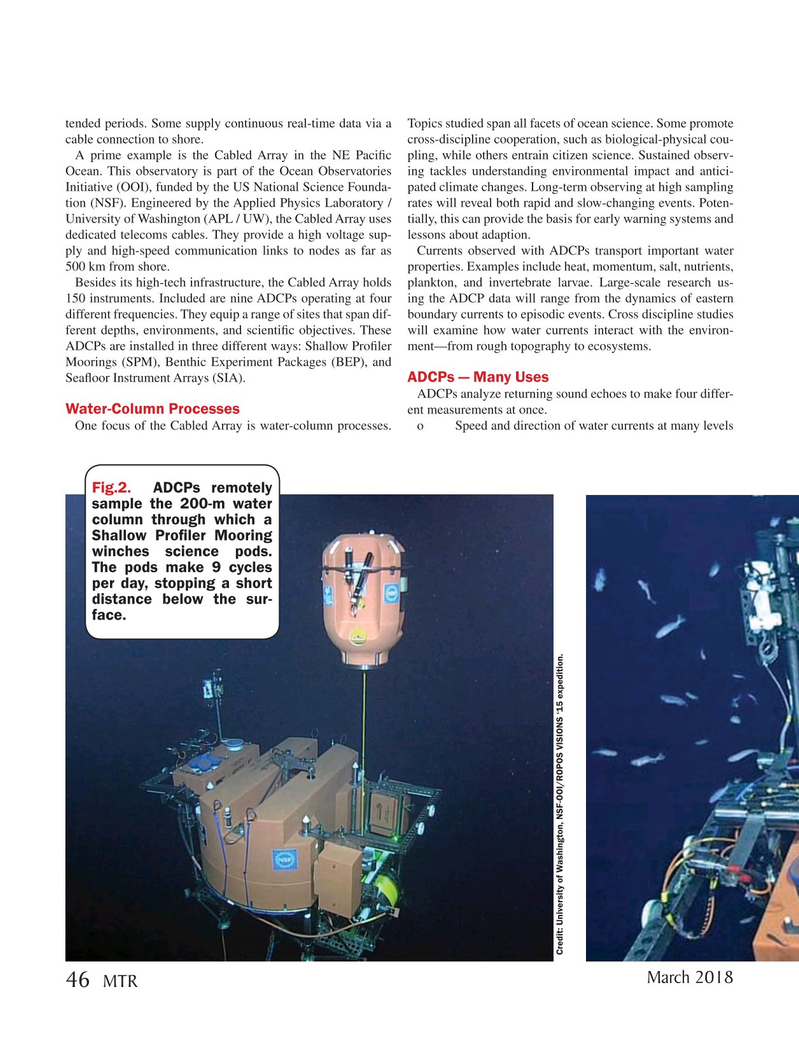
Page 46: of Marine Technology Magazine (March 2018)
Oceanographic Instrumentation: Measurement, Process & Analysis
Read this page in Pdf, Flash or Html5 edition of March 2018 Marine Technology Magazine
tended periods. Some supply continuous real-time data via a Topics studied span all facets of ocean science. Some promote cable connection to shore. cross-discipline cooperation, such as biological-physical cou-
A prime example is the Cabled Array in the NE Paci? c pling, while others entrain citizen science. Sustained observ-
Ocean. This observatory is part of the Ocean Observatories ing tackles understanding environmental impact and antici-
Initiative (OOI), funded by the US National Science Founda- pated climate changes. Long-term observing at high sampling tion (NSF). Engineered by the Applied Physics Laboratory / rates will reveal both rapid and slow-changing events. Poten-
University of Washington (APL / UW), the Cabled Array uses tially, this can provide the basis for early warning systems and dedicated telecoms cables. They provide a high voltage sup- lessons about adaption.
ply and high-speed communication links to nodes as far as Currents observed with ADCPs transport important water 500 km from shore. properties. Examples include heat, momentum, salt, nutrients,
Besides its high-tech infrastructure, the Cabled Array holds plankton, and invertebrate larvae. Large-scale research us- 150 instruments. Included are nine ADCPs operating at four ing the ADCP data will range from the dynamics of eastern different frequencies. They equip a range of sites that span dif- boundary currents to episodic events. Cross discipline studies ferent depths, environments, and scienti? c objectives. These will examine how water currents interact with the environ-
ADCPs are installed in three different ways: Shallow Pro? ler ment—from rough topography to ecosystems.
Moorings (SPM), Benthic Experiment Packages (BEP), and
Sea? oor Instrument Arrays (SIA). ADCPs — Many Uses
ADCPs analyze returning sound echoes to make four differ-
Water-Column Processes ent measurements at once.
One focus of the Cabled Array is water-column processes. o Speed and direction of water currents at many levels
Fig.2. ADCPs remotely sample the 200-m water column through which a
Shallow Pro? ler Mooring winches science pods.
The pods make 9 cycles per day, stopping a short distance below the sur- face.
Credit: University of Washington, NSF-OOI/ROPOS VISIONS ‘15 expedition.
March 2018 46
MTR
MTR #2 (34-49).indd 46 MTR #2 (34-49).indd 46 2/20/2018 4:14:39 PM2/20/2018 4:14:39 PM

 45
45

 47
47
